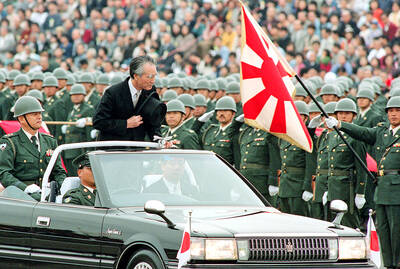The Joint Strike Fighter -- a US$256 billion fighter program led by the US and co-financed by eight allied nations -- was supposed to be a model of international cooperation. But because of US reluctance to share critical technologies, some of the biggest partners are now threatening to withdraw.
This week, Britain, the principal foreign partner in the program to build the next-generation radar-evading supersonic jet, delivered an ultimatum at a Senate Armed Services Committee hearing. Lord Peter Drayson, Britain's top weapons buyer, said that the UK would withdraw from the program unless it gained better access to software technology and stealth technology needed to maintain and upgrade the planes it buys.
The British have invested US$2 billion so far and planned to spend another US$9 billion to purchase 150 aircraft.
In addition, Drayson objected to a recent Pentagon decision to drop a Rolls-Royce-General Electric engine from the program and pointedly told the committee that his country was not even consulted on the decision. The Pentagon wants to make Pratt & Whitney the sole engine supplier for the warplane, a move it says would save US$1.8 billion in near-term costs. The cut is in the Pentagon's budget proposal for next year.
"I am spelling this out because it is so important to make our intentions clear," Drayson said. "Without the technology transfer to give us the confidence to deliver an aircraft fit to fight on our terms, we will not be able to buy these aircraft."
To underscore its resolve, Britain's "shadow" defense secretary, Liam Fox, who represents the Conservative Party, attended the hearing to emphasize bipartisan support.
"The British public is getting the perception they are being asked to shoulder their share of responsibility, but not get their share of contracts," Fox said in a telephone interview.
"We are not being treated as a partner of the United States, but as a supplicant," he said.
Meanwhile, five other nations that are partners in the project -- Norway, Italy, Turkey, Denmark and the Netherlands -- met last Friday in the Netherlands to lay the groundwork for a united front to deal with the Pentagon.
Along with Canada and Australia, these foreign partners have contributed more than US$4 billion to the program's US$20 billion development costs.
Should any country withdraw, it would be a major embarrassment to the US-led effort, particularly since the Pentagon is trying to sign up partners to commit to the production phase and indicate the size of their orders.

The Venezuelan government on Monday said that it would close its embassies in Norway and Australia, and open new ones in Burkina Faso and Zimbabwe in a restructuring of its foreign service, after weeks of growing tensions with the US. The closures are part of the “strategic reassignation of resources,” Venezueland President Nicolas Maduro’s government said in a statement, adding that consular services to Venezuelans in Norway and Australia would be provided by diplomatic missions, with details to be shared in the coming days. The Norwegian Ministry of Foreign Affairs said that it had received notice of the embassy closure, but no

A missing fingertip offers a clue to Mako Nishimura’s criminal past as one of Japan’s few female yakuza, but after clawing her way out of the underworld, she now spends her days helping other retired gangsters reintegrate into society. The multibillion-dollar yakuza organized crime network has long ruled over Japan’s drug rings, illicit gambling dens and sex trade. In the past few years, the empire has started to crumble as members have dwindled and laws targeting mafia are tightened. An intensifying police crackdown has shrunk yakuza forces nationwide, with their numbers dipping below 20,000 last year for the first time since records

EXTRADITION FEARS: The legislative changes come five years after a treaty was suspended in response to the territory’s crackdown on democracy advocates Exiled Hong Kong dissidents said they fear UK government plans to restart some extraditions with the territory could put them in greater danger, adding that Hong Kong authorities would use any pretext to pursue them. An amendment to UK extradition laws was passed on Tuesday. It came more than five years after the UK and several other countries suspended extradition treaties with Hong Kong in response to a government crackdown on the democracy movement and its imposition of a National Security Law. The British Home Office said that the suspension of the treaty made all extraditions with Hong Kong impossible “even if

Former Japanese prime minister Tomiichi Murayama, best known for making a statement apologizing over World War II, died yesterday aged 101, officials said. Murayama in 1995 expressed “deep remorse” over the country’s atrocities in Asia. The statement became a benchmark for Tokyo’s subsequent apologies over World War II. “Tomiichi Murayama, the father of Japanese politics, passed away today at 11:28am at a hospital in Oita City at the age of 101,” Social Democratic Party Chairwoman Mizuho Fukushima said. Party Secretary-General Hiroyuki Takano said he had been informed that the former prime minister died of old age. In the landmark statement in August 1995, Murayama said